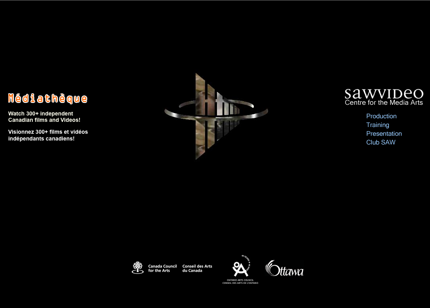Mélanie Hogan: Crashing the Archive: A Research-Creation Intervention into the SAW Video Mediatheque (2012)
Filed under thesis | Tags: · archive, archiving, preservation, storage, video art

“Video Cache is a research creation intervention emerging from my doctoral research into defunct and crashed online archives, in the context of Canadian video art, which has a rich history of self-preservation and of documenting itself as an art movement. From major art galleries to personal collections; Canada has long privileged video as a tool for creative resistance, expression, and experimentation. Video Cache serves to track the SAW Video Mediatheque (based in Ottawa), from its launch to its crash and back online again, by updating its context and addressing in a practical way what it means to ‘activate’ the online archive. Much of my intervention occurred after the crash and during the two years the site was offline. It involved varied methodological entry points including in depth interviews with SAW Video staff and media archaeology to locate digital traces of the site. Key here is Video Cache’s success in simultaneously documenting the project and intervening to address archival loss: while it was the ‘cache’ that made the Mediatheque’s traces visible and re-visit-able, it was the ‘crash’ that signalled its ongoing archival value.” (from Abstract)
PhD thesis
Department of Communication Studies, Concordia University, Montréal, Québec, Canada
April 2012
Digital Forensics and Born-Digital Content in Cultural Heritage Collections (2010)
Filed under report | Tags: · archive, cultural heritage, digital forensics, forensics, library, preservation

“While the purview of digital forensics was once specialized to fields of law enforcement, computer security, and national defense, the increasing ubiquity of computers and electronic devices means that digital forensics is now used in a wide variety of cases and circumstances. Most records today are born digital, and libraries and other collecting institutions increasingly receive computer storage media as part of their acquisition of “papers” from writers, scholars, scientists, musicians, and public figures. This poses new challenges to librarians, archivists, and curators—challenges related to accessing and preserving legacy formats, recovering data, ensuring authenticity, and maintaining trust. The methods and tools developed by forensics experts represent a novel approach to these demands. For example, the same forensics software that indexes a criminal suspect’s hard drive allows the archivist to prepare a comprehensive manifest of the electronic files a donor has turned over for accession.
This report introduces the field of digital forensics in the cultural heritage sector and explores some points of convergence between the interests of those charged with collecting and maintaining born-digital cultural heritage materials and those charged with collecting and maintaining legal evidence.”
Written by Matthew G. Kirschenbaum, Richard Ovenden, Gabriela Redwine, with research assistance from Rachel Donahue
Publisher Council on Library and Information Resources, pub149, December 2010
ISBN 9781932326376
93 pages
PDF, PDF (updated on 2018-12-6)
Comment (0)Anne Laforet: La conservation du net art au musée. Les stratégies à l’œuvre (2009) [French]
Filed under thesis | Tags: · internet, internet art, media art, net art, preservation
“The preservation of net art is a complex topic which requires the construction of a specific approach to look at internet artwork, one that takes into account the material dimension of the artwork. Preservation does not deal only with aesthetics, not only about the way the audience experiences artworks, but needs to have access to these types of information so the preservation process can take place.
This research presents an overview of works created by and for the Internet. The artworks which are described in this work are chosen specifically as examples for preservation purposes, and not according to a typology created for different purposes. This research also presents an overview of the institutions (based in Europe and in North America) that have developped specific preservation strategies. It takes the form of case analyses, which stem from observations, readings, and interviews.
This thesis also looks into the interaction between preservation and the other functions of the museum (collection, exhibition, research). Preservation cannot be tackled independantly, because it deals with the artwork’s life cycle within the museum. Every art work has to be treated in a way which is specific to itself. The issue of notation also arises then, as it’s necessary to find ways to describe artworks, especially as their technological environments will eventually be obsolete. This research explores the ways to compensate obsolescence: emulation, migration, score, re-interpretation, self-archiving, automatic archiving, etc (which can be also combined).
The attention to net art work as material socio-technical object means to find a way to look at those works : the code which composes the artwork, the files, its different files and the way they are organized, what happens on the screen, the interactions between the artward and the audience that experience it. The notions of code performativity and activation are useful in this approach.
Preservation happens only when value is attributed to what is preserved. Two categories of actors outside of the museum take part into this process: the art market on the one hand and art critics and art historians on the other. Both influence and get influenced by the museum.
All these elements allow the composition of a pluridisciplinar cartography on the topic of net art preservation.”
The preservation of Net Art in museums. The strategies at work
PhD thesis, University of Avignon, France
Supervisor: Jean Davallon

